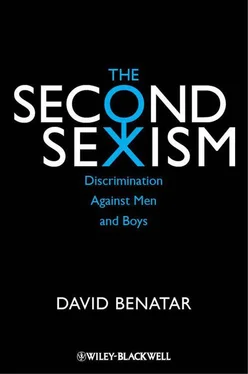Male disadvantages include the absence of immunity, typically enjoyed by females, from conscription into military service. Men, unlike women, are not only conscripted but also sent into combat, where they risk injury, both physical and psychological, and death. Men are also disproportionately the victims of violence in most (but not all) non-combat contexts. For example, most victims of violent crime are male, and men are often (but again not always) specially targeted for mass killing. Males are more likely than females to be subject to corporal punishment. Indeed, sometimes such punishment of females is prohibited, while it is permitted, if not encouraged, for males. Although males are less often victims of sexual assault than are females, the sexual assault of males is typically taken less seriously and is thus even more significantly under-reported. Fathers are less likely than mothers to win custody of their children in the event of divorce. These and other examples will be presented in some, but by no means exhaustive detail, in Chapter 2.
However, demonstrating the existence of male disadvantage is, by itself, insufficient to show that males are the victims of sexism. Not all disadvantages somebody suffers on the basis of his or her sex amount to sexism. By way of illustration, consider the following. The disease called hereditary haemochromatosis is a genetic condition in which the body gradually absorbs too much iron, storing it in major organs. If the condition is not detected in time, serious organ damage and failure can result, often resulting in death. The treatment, if the condition is detected sufficiently early, is regular blood-letting. 4 4 Blood-letting was once a standard medical treatment for dozens of conditions. Haemochromatosis is one of only a few conditions for which it is actually a suitable treatment.
Although both males and females can have this genetic condition, males are more likely to suffer from the resultant disease. This is because females, during their reproductive years, regularly lose blood, and thus iron, during menstruation. 5 5 While older woman do not menstruate, the onset of iron accumulation in those with haemochromatosis tends to begin sufficiently late in their life that they either die of something else first or only suffer the symptoms very late.
It thus transpires that menstruation is an advantage for those females with haemochromatosis. But menstruation can also be a disadvantage. Because younger women do lose blood and iron, they are more prone than are men to iron deficiency anemia. Menstruation is thus an advantage for women with haemochromatosis, but a disadvantage for women who are susceptible to iron deficiency anemia. Similarly, the absence of menstruation is a health disadvantage for men with haemochromatosis, but an advantage for men who might otherwise be susceptible to iron deficiency.
The presence or absence of these disadvantages does not demonstrate that males with symptomatic haemochromatosis and females with iron deficiency anemia are the victims of sexism .
To understand the relationship between disadvantage (on the basis of sex) and sexism, there are a number of concepts we need to understand and distinguish. First, we need to distinguish disadvantage from discrimination. The man with haemochromatosis is disadvantaged by not menstruating, but he is not discriminated against. For there to be discrimination the disadvantage must be at least partly the product of agency, or, on some views, of social structures or practices. Thus an individual, an institution or a state might discriminate against people of one sex. Or it might be the case that particular social structures or practices have the effect of favoring one sex over the other. The disadvantage suffered by the man with haemochromatosis is not in itself the product of any of these. For example, nobody forbade or discouraged him from menstruating or removed the uterus he never had, or prevented him from acquiring one. 6 6 Fans of Monty Python’s Life of Brian will remember that a man’s lack of a uterus is “nobody’s fault, not even the Romans’.”
We cannot conclude, however, that whenever some disadvantage is experienced as a result of discrimination on the basis of sex that the person suffering the disadvantage is the victim of sexism. This is because discrimination is sometimes entirely appropriate, if not desirable. The word “discrimination” is so often used in its pejorative sense that it is sometimes forgotten that it also has an entirely non-pejorative sense. To discriminate is to recognize a difference or to differentiate. Some discrimination in this sense is both necessary and desirable. Teachers, for example, must discriminate — discern the difference — between good- and bad-quality work submitted by their students. If teachers awarded first-class passes for all work, or failed all work, irrespective of its quality, they would not be acting in an appropriately discriminating way.
This brings us to a second distinction, namely between discrimination and unfair or wrongful discrimination. Whereas discrimination per se can be morally acceptable, wrongful discrimination is, by definition, morally problematic.
There are obviously many possible grounds on which one might wrongly discriminate. These include sex, race, religion, ethnic group, national origin and sexual orientation. Of interest in this book is wrongful discrimination on the basis of a person’s sex. 7 7 As implied in note 2 above, I am interested in sex discrimination rather than gender discrimination. Although there are different ways of drawing the distinction, a common one is between the biological or anatomical condition of being male or female — a person’s sex — and attributes that are socially designated as being masculine or feminine — a person’s gender. Thus a person who is anatomically male might be feminine and a person who is masculine might be anatomically female. I am fundamentally interested in sex discrimination because I am interested in discrimination against people who are anatomically male (or who are perceived as such). This is the complement to concern about discrimination against people who are anatomically female. Of course, sex discrimination and gender discrimination are related. Sexists tend to assume that males should be masculine and females should be feminine, but the expectation is that people’s gender matches their sex. Masculine women do not escape discrimination against females, and feminine men do not escape discrimination against males.
However, sex is not always an inappropriate basis on which to discriminate between people. Thus once one has established that a disadvantage is the product of discrimination on the basis of somebody’s sex, one then needs to establish whether or not that discrimination is fair, just or justifiable. That is to say, one must determine whether or not a person’s sex provides an appropriate basis for the differential treatment. For example, one might say that middle-aged males are discriminated against if their medical insurance does not cover them, but does cover females of similar age, for routine mammography. However, one might argue that the discrimination is not unfair on account of a relevant difference between men and women. Women, given the nature of their breasts, are more likely to get breast cancer, and thus the cost of routine scanning may be warranted for them but not for men. (We can imagine exceptions, of course. If some subset of males were known to have an elevated risk of breast cancer, we might think it unfair if they, unlike other men, were not covered.)
As we might expect, there is disagreement about the correct account of when discrimination is wrong. My preferred answer is that discrimination is wrong when people are treated differently without there being a relevant difference between the people that justifies the differential treatment. (When I speak of the differential treatment being justified , I do not mean that some or other reason is offered for the differential treatment, but rather that there is good objective reason for the differential treatment.) If, for example, a teacher were to fail work that deserves to pass and does so on account of its having been written by a student of a particular sex, race, religion, ethnic group or sexual orientation, then that teacher has also acted unfairly and wrongly. Such features of the author of a piece of written work are irrelevant to assessing the quality of that work.
Читать дальше
Конец ознакомительного отрывка
Купить книгу












